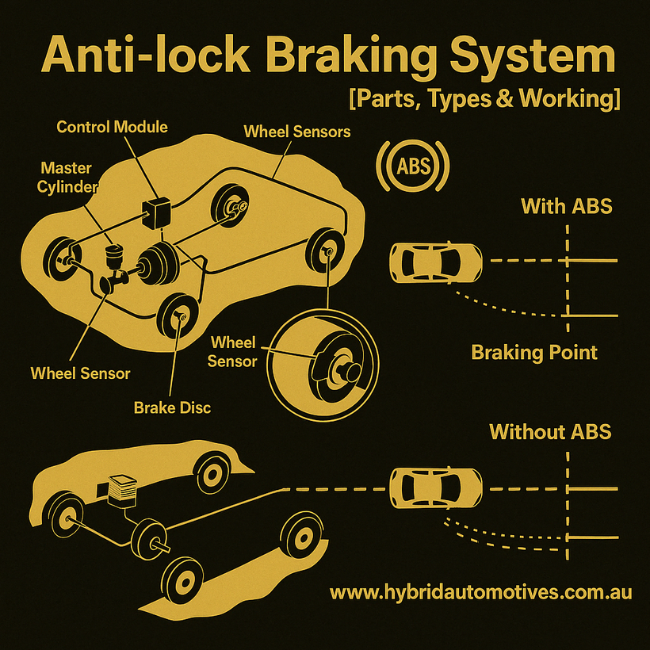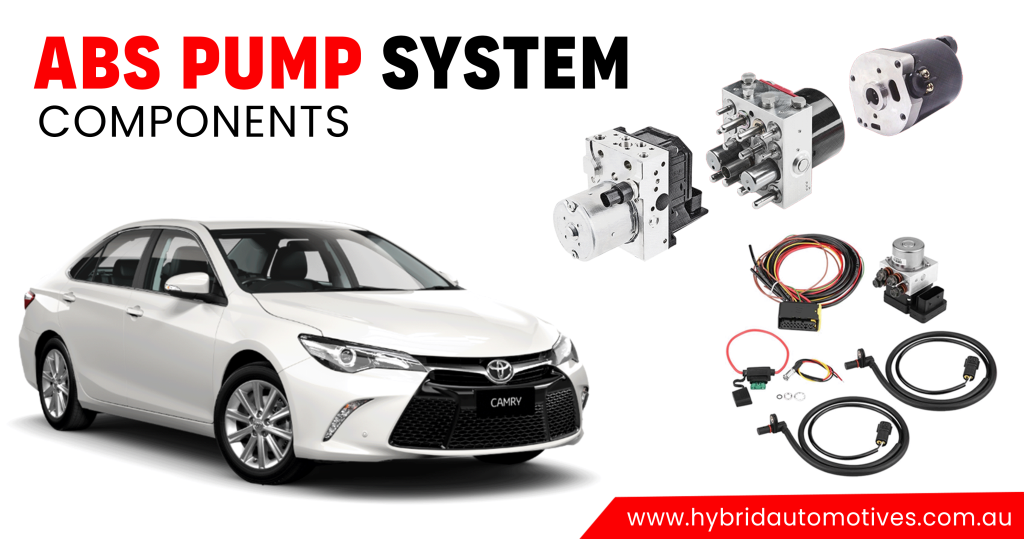Understanding the Role of ABS Pump in Car Brakes

An ABS (Anti-lock Braking System) pump is an essential component of modern vehicles, contributing significantly to road safety. Explore ABS Pumps in detail, explaining how they work, what parts they have, their advantages, common problems, how to take care of them, and advancements in their technology. Introduction to ABS Pump In today’s automotive landscape, safety is paramount, and the ABS pump plays a crucial role in ensuring safe braking maneuvers. Essentially, an ABS pump is like a smart brake system. It has a hydraulic part and a control unit that work together to stop your wheels from locking up when you brake. This helps you keep control of your steering and grip on the road. Components of ABS Pump An ABS (Anti-lock Braking System) pump consists of several parts that work together to ensure effective braking in vehicles. These components include: Hydraulic Unit: The hydraulic unit of the ABS pump is responsible for regulating brake pressure during operation. It has valves and pistons inside that control the pressure of the brake fluid to stop the wheels from locking up. Electronic Control Unit (ECU): The ECU is like the ABS’s brain. It processes data from wheel speed sensors and controls the operation of the hydraulic unit to prevent skidding during braking. Wheel Speed Sensors: These sensors are placed on each wheel and keep track of how fast the wheels are spinning. The data collected by the wheel speed sensors helps the ECU determine if any wheels are at risk of locking up during braking. How ABS Pump Works ? The ABS pump works by checking how fast each wheel is moving all the time. If it notices one wheel is slowing down too much, it changes how hard the brakes press to stop it from locking up while you’re braking. Here’s an easy way to understand how it works: Detection of Wheel Speed: The ABS has sensors on each wheel that check how fast they’re spinning. These sensors send information to the ABS control module in real-time. Analysis by Control Module: The ABS control module keeps looking at the information it gets from the wheel sensors all the time. If it detects that one or more wheels are decelerating too rapidly, indicating a potential lock-up situation, it activates the ABS. Pressure Modulation: Upon activation, the ABS control module signals the ABS pump to modulate brake pressure. It does this by quickly pressing and releasing the brakes on the wheels that need it. Prevention of Wheel Lock-up: By adjusting the pressure of the brakes, the ABS pump stops the wheels from locking up. This helps the driver steer the car. This helps the vehicle to maintain traction and stability during braking, especially in slippery or emergencies. Monitoring and Adjustment: The ABS continuously monitors wheel speed and adjusts brake pressure as needed throughout the braking process. Once the ABS control module determines that the risk of wheel lock-up has been mitigated, it allows the brakes to function normally again. Benefits of ABS Pump The ABS (Anti-lock Braking System) pump offers several advantages that contribute to improved vehicle safety and performance. Here are the key benefits: Enhanced Vehicle Control: One big advantage of the ABS pump is that it helps you control your car better when you brake. It stops the wheels from locking up, so you can still steer even if you’re braking hard or driving on a slippery road. Reduced Braking Distance: ABS pumps help to reduce braking distance by preventing wheel skidding. By ensuring that the wheels continue to rotate during braking, the ABS system allows the vehicle to come to a stop more quickly, potentially reducing the risk of accidents. Prevention of Skidding and Loss of Control: Skidding can occur when one or more wheels lock up during braking, causing the vehicle to slide uncontrollably. The ABS pump prevents this by modulating brake pressure, thereby reducing the likelihood of skidding and loss of control. Improved Stability in Emergency Braking: During emergency braking maneuvers, the ABS pump helps to maintain stability and control by preventing wheel lock-up. This lets the driver turn the car away from things on the road while they’re braking, which makes crashes less likely. Better Performance in Adverse Conditions: ABS pumps are particularly beneficial in adverse driving conditions such as wet, icy, or gravelly roads. By preventing wheel lock-up, the ABS helps to maintain traction and stability, even when road conditions are challenging. Common Issues with ABS Pump While ABS (Anti-lock Braking System) pumps are designed to enhance vehicle safety, they can encounter various issues over time. Understanding these common issues is crucial for maintaining the functionality of the ABS. Here are some of the most frequent problems associated with ABS pumps: Sensor Malfunction: The ABS needs wheel speed sensors to work because they tell it how fast each wheel is spinning. Sensor malfunctions, such as dirt accumulation, corrosion, or wiring faults, can lead to inaccurate readings and trigger ABS warning lights. Pump Failure: The ABS pump itself can fail due to mechanical issues or electrical faults. Parts inside the ABS pump can get old and worn out, which can make it work less well or stop working altogether. Problems with the electrical system, like broken wires or bad relays, can also make the ABS pump stop working right. Electronic Faults: The electronic control unit (ECU) of the ABS may encounter faults or glitches, leading to erratic behavior or complete system failure. Issues with the ECU can arise due to software errors, voltage irregularities, or damage to electronic components. Fluid Contamination: Contaminated brake fluid can compromise the performance of the ABS pump and other hydraulic components. Moisture, air bubbles, or debris in the brake fluid can interfere with the operation of valves and pistons within the hydraulic unit, leading to reduced braking effectiveness. Brake Fluid Leaks: If there are holes in the hydraulic system, the brake fluid can leak out. This makes the hydraulic pressure lower and might make the ABS pump stop working. Common
Steps Involved in Replacing an ABS pump

Step-by-Step Guide to Replace ABS Pump Changing the ABS (Anti-lock Braking System) pump is really important for keeping your car’s brakes working well and safe. Whether you’re a seasoned mechanic or a DIY enthusiast, understanding the steps involved in this process can help you tackle the task with confidence and precision. The ABS pump is a vital component of modern vehicles’ braking systems, responsible for preventing wheel lock-up during emergency braking situations. Over time, due to wear and tear or electrical malfunctions, the ABS pump may require replacement. Understanding the ABS Pump Before starting the replacement, it’s important to know what the ABS pump does. Essentially, it regulates brake pressure to prevent skidding and maintain control during sudden stops. The ABS pump achieves this by rapidly modulating brake pressure to individual wheels, preventing them from locking up. This technology enhances vehicle stability and reduces the risk of accidents during emergency braking situations. Additionally, the ABS pump constantly monitors wheel speed using sensors, allowing it to adjust brake pressure in real time. By preventing wheel lock-ups, it ensures safer and more controlled braking, particularly on slippery or uneven road surfaces. Signs of a Faulty ABS Pump Signs of a bad ABS pump can show up in different ways, signaling possible problems with your car’s brakes. These signs include: Illuminated ABS Warning Light: One of the most apparent indicators of a faulty ABS pump is when the ABS warning light illuminates your vehicle’s dashboard. This light typically alerts you to a problem within the ABS, including issues with the pump. Unusual Brake Pedal Behavior: A faulty ABS pump can cause irregularities in the brake pedal’s response. You may notice the pedal feels spongy or unresponsive when pressed, indicating potential problems with brake pressure regulation. Vibrations During Braking: If you feel shaking or vibrating in the brake pedal or steering wheel when you press the brakes, it might mean there’s something wrong with the ABS pump. These shakes can happen when you brake normally or especially when you brake suddenly in an emergency. Increased Stopping Distance: A faulty ABS pump may lead to an increase in the vehicle’s stopping distance, especially during sudden or hard braking maneuvers. This diminished braking performance can compromise safety on the road. ABS System Failure: In severe cases, a malfunctioning ABS pump can result in the complete failure of the ABS. This failure may cause the vehicle’s brakes to behave erratically or lose their anti-lock functionality altogether. Strange Noises: A bad ABS pump might make strange sounds like grinding, whirring, or buzzing, especially when you brake. These noises could mean there’s a problem with the pump or the whole ABS. Brake Fluid Leaks: Leaks around the ABS pump or brake lines can signify a problem with the pump’s hydraulic components. If brake fluid leaks out, your brakes might not work as well, which can be dangerous. ABS Pump Motor Failure: If the ABS pump’s motor fails, it can result in the inability to regulate brake pressure effectively. This failure may cause erratic braking behavior or complete loss of ABS functionality. Dashboard Messages or Codes: Modern vehicles equipped with onboard diagnostic systems may display specific error codes related to ABS malfunctions. These codes can help pinpoint the exact issue with the ABS pump or related components. Preparing for Replacement Getting ready to replace your ABS pump means doing a few important things to make sure everything goes well and you stay safe. Here’s what you need to do: Tools and Materials Needed: Gather the necessary tools and materials, including jack stands, a hydraulic jack, wrenches, sockets, brake fluid, and a new ABS pump. Safety Precautions: Make sure your vehicle is parked on a flat surface and follow safety rules like wearing protective gear and turning off the battery. Step-by-Step Guide to Replacing an ABS Pump Replacing an ABS (Anti-lock Braking System) pump is a crucial maintenance task for ensuring the safety and efficiency of your vehicle’s braking system. We’ll walk you through the process of replacing an ABS pump step by step. Step 1: Lift the Vehicle: Use a hydraulic jack to raise the vehicle off the ground, then use jack stands to keep it steady while you work. This gives you plenty of room to work safely. Step 2: Locate the ABS Pump: Identify the ABS pump’s location, typically near the brake master cylinder or firewall. Step 3: Disconnect the Battery: To avoid electrical accidents, take out the car’s battery and wait a bit before you do anything else. Step 4: Remove the Old ABS Pump: Carefully disconnect the electrical connectors and hydraulic lines attached to the old ABS pump, then unbolt it from its mounting bracket. Step 5: Install the New ABS Pump: Put the new ABS pump in its spot and use bolts to hold it in place. Reconnect electrical connectors and hydraulic lines. Step 6: Reconnect Components: Reconnect the battery and double-check that everything is fastened tightly. Double-check connections and tighten any loose bolts. Testing the Replacement After completing the replacement process, perform a thorough test by starting the vehicle and checking for any leaks or unusual sounds. Take the vehicle for a test drive to ensure proper functionality of the braking system. Tips for Maintenance and Care To prolong the life of your new ABS pump and ensure optimal performance, consider the following tips: Regularly inspect the ABS for any signs of leaks or damage. Keep an eye on the ABS warning light and address any issues promptly. Follow the manufacturer’s recommendations for brake fluid replacement intervals.
Overview of ABS Pump System Components

In-car safety, the Anti-lock Braking System (ABS) is really important. It helps keep the car steady and lets you control it better when you brake. Central to the functionality of ABS are sensors, valves, and electronic control units (ECUs) that work together seamlessly within the ABS pump system. Sensors in ABS Pump System The sensors within the ABS pump system are pivotal components that contribute to the system’s functionality and effectiveness in enhancing vehicle safety during braking. Wheel Speed Sensors At the heart of the ABS pump system are wheel speed sensors. These sensors are strategically positioned at each wheel to monitor its rotational speed. As the vehicle moves, the wheel speed sensors continuously send signals to the electronic control unit (ECU), providing real-time data on the speed of each wheel. Role in Preventing Wheel Lock-Up The primary function of wheel speed sensors is to detect any discrepancies in wheel speeds. In the event of rapid deceleration or sudden braking, if one or more wheels begin to lock up or lose traction, the wheel speed sensors immediately detect this change. This is important for the ABS to step in and adjust brake pressure as needed. Real-Time Feedback to the ECU Wheel speed sensors act as the eyes of the ABS, providing vital feedback to the ECU. Based on the data received from the sensors, the ECU evaluates the current state of each wheel and determines whether intervention is necessary to prevent wheel lock-up. Ensuring Optimal Braking Performance By continuously monitoring wheel speeds and providing real-time feedback to the ECU, wheel speed sensors play a critical role in ensuring optimal braking performance. The ABS can adjust brake pressure individually for each wheel, allowing the vehicle to maintain stability and control during braking, even on slippery or uneven surfaces. Valves in ABS Pump System Valves are integral components within the ABS pump system, playing a crucial role in regulating brake fluid flow and modulating brake pressure to prevent wheel lock-up during braking maneuvers. Solenoid Valves The primary type of valve used in ABS pump systems is the solenoid valve. These valves are devices powered by electricity and mechanics. They control how brake fluid moves to each wheel. Solenoid valves are strategically located within the hydraulic unit of the ABS pump system. Modulating Brake Pressure When the ABS system detects impending wheel lock-up, it activates the solenoid valves to modulate brake pressure rapidly. By opening and closing these valves in quick succession, the ABS system can adjust brake pressure on a wheel-by-wheel basis, ensuring optimal braking performance and vehicle stability. Rapid Response Mechanism One of the key advantages of solenoid valves is their ability to respond rapidly to changing driving conditions. In the event of sudden deceleration or loss of traction, the ABS system can activate the solenoid valves within milliseconds, allowing for immediate adjustment of brake pressure to prevent wheel lock-up. Integral to ABS Functionality Valves, particularly solenoid valves, are essential for the effective operation of the ABS pump system. Their ability to modulate brake pressure in real-time based on sensor inputs is crucial for preventing wheel lock-up and maintaining vehicle control during braking maneuvers. Electronic Control Units (ECUs) in ABS Pump System Electronic Control Units (ECUs) play a pivotal role in the functionality and operation of the ABS pump system, serving as the central intelligence behind the system’s ability to prevent wheel lock-up and maintain vehicle stability during braking. The brain of the ABS System ECUs act as the brains of the ABS, orchestrating the interaction between various components such as sensors, valves, and the hydraulic unit. They receive real-time data from wheel speed sensors and other sensors throughout the vehicle, allowing them to monitor wheel speeds and detect any deviations that may indicate impending wheel lock-up. Processing Sensor Inputs Upon receiving sensor inputs, ECUs process this data using sophisticated algorithms to determine the appropriate course of action. They analyze factors such as vehicle speed, road conditions, and driver inputs to calculate the optimal braking strategy for each wheel. Issuing Brake Pressure Commands Based on the analysis of sensor inputs, ECUs issue commands to the solenoid valves within the hydraulic unit to modulate brake pressure accordingly. They can change how much pressure each wheel’s brakes get. This helps the ABS system stop the wheels from locking up and keeps the car steering and staying stable. Real-Time Adjustment One of the key functions of ECUs is their ability to make real-time adjustments to brake pressure based on changing driving conditions. In emergency braking situations or on slippery surfaces, ECUs can rapidly adjust the brake pressure to prevent wheel lock-up and ensure effective braking performance. Integration with Vehicle Systems The ECUs in the ABS pump are usually connected to other car systems like traction control and stability control. This helps them all work together smoothly, making the car more stable and easier to control when braking or turning corners. Integration of Components in ABS Pump System The seamless interaction between sensors, valves, and ECUs is crucial for the effective operation of the ABS pump system. Sensors provide real-time data to the ECU, which then interprets this information and commands the valves to modulate brake pressure accordingly. This integrated approach allows the ABS system to respond rapidly to changing driving conditions and prevent wheel lock-up while maintaining steering control. Importance of Proper Functioning Ensuring the proper functioning of sensors, valves, and ECUs within the ABS pump system is paramount for vehicle safety. Any malfunction or failure in these components can compromise the effectiveness of the ABS system, potentially leading to loss of control during braking and increased risk of accidents. Regular check-ups and fixing problems quickly are important to find and solve any issues. Maintenance and Troubleshooting Common issues with sensors, valves, and ECUs in the ABS pump system include sensor calibration errors, valve blockages, and ECU malfunctions. Figuring out and fixing these problems needs special tools and knowledge. Regular inspection and maintenance by qualified technicians can help prevent ABS failures and ensure
Components and Mechanisms Involved in ABS Pump Operation

In-car safety, the Anti-lock Braking System (ABS) is crucial for stopping accidents and keeping control when braking suddenly. At the heart of this system lies the ABS pump, which orchestrates a series of intricate processes to maintain traction and stability while braking. Components of an ABS Pump The Anti-lock Braking System (ABS) is really important in today’s cars. It stops the wheels from locking up when you brake hard and helps you steer safely in emergencies. Understanding the components of an ABS pump is essential to grasp how this system functions effectively. Hydraulic Unit At the core of the ABS pump lies the hydraulic unit. This part makes and controls the pressure in the brakes. It consists of a pump, valves, and hydraulic lines that deliver brake fluid to the brakes when needed. The hydraulic unit is really important for adjusting brake pressure to stop the wheels from locking up and to make sure the brakes work well. Electronic Control Unit (ECU) The Electronic Control Unit, known as the ECU, acts as the ABS’s brain. It gets information from different sensors, like the ones that measure wheel speed, and uses it to figure out how to brake properly. The ECU continuously monitors wheel speed and other parameters, issuing commands to modulate brake pressure when necessary. It plays a crucial role in coordinating the operation of the ABS and ensuring optimal performance in diverse driving conditions. Wheel Speed Sensors Wheel speed sensors are integral to the functioning of the ABS pump. These sensors find out how fast each wheel is spinning and send that information to the ECU. By monitoring wheel speed, the ABS system can detect potential wheel lock-up and intervene to prevent it. Wheel speed sensors provide real-time feedback to the ECU, enabling precise control of brake pressure to maintain traction and stability during braking. Valves ABS pumps have valves that use electricity to control the brake fluid going to each wheel. They make sure the brakes don’t lock up and keep the car steering properly. When the ABS detects impending wheel lock-up, it activates the solenoid valves to release or increase brake pressure as needed. Valves play a crucial role in the rapid adjustment of brake pressure, allowing the ABS to respond swiftly to changing driving conditions. Mechanisms of ABS Pump Operation Understanding how an ABS pump operates involves delving into its intricate mechanisms: Normal Braking vs. ABS Braking During regular braking, the brake pedal actuates the hydraulic system, applying pressure to the brakes. But ABS brakes work differently. They keep checking how fast the wheels are spinning and change the brake pressure to stop them from locking up. This dynamic intervention ensures that the vehicle maintains traction and stability, even during sudden braking or slippery road conditions. Sensor Inputs and Feedback A crucial aspect of ABS operation is the input from wheel speed sensors. These sensors feel how fast each wheel is spinning and send that information to the Electronic Control Unit (ECU). The ECU analyzes this information in real-time to detect potential wheel lock-up situations. By continuously monitoring wheel speed, the ABS can respond promptly to changes in driving conditions, ensuring optimal braking performance. Modulation of Brake Pressure When the ABS system detects imminent wheel lock-up, it intervenes by modulating brake pressure. This modulation is achieved through rapid adjustments in the solenoid valves within the hydraulic unit. By opening and closing these valves at precise intervals, the ABS Pump system regulates brake pressure to prevent wheel lock-up while maintaining steering control. This dynamic modulation ensures that the vehicle can stop safely and efficiently, even under challenging driving conditions. Anti-lock Braking Algorithms ABS systems employ sophisticated algorithms to determine the ideal braking strategy for each wheel. These algorithms take into account various factors, including vehicle speed, road conditions, and driver inputs. By continuously analyzing sensor data and adjusting brake pressure accordingly, ABS systems can optimize braking performance while minimizing the risk of wheel lock-up. These anti-lock braking algorithms are essential for ensuring the safety and stability of the vehicle during emergency braking situations. Integration with Vehicle Systems ABS pumps usually team up with other safety systems in the car. ABS with Traction Control: Integrated ABS and traction control systems further enhance vehicle stability by managing wheel slip during acceleration and braking. ABS with Electronic Stability Control: Modern vehicles may feature ABS integrated with Electronic Stability Control (ESC), which helps maintain vehicle stability by selectively applying brakes to individual wheels. Maintenance and Troubleshooting Ensuring the proper functioning of an ABS pump requires periodic maintenance and troubleshooting: Common Issues with ABS Pumps: Problems such as sensor malfunctions, hydraulic leaks, or ECU failures may impair ABS performance. Diagnostic Tools and Techniques: Mechanics use specialized diagnostic tools to identify ABS-related issues, including OBD scanners and ABS code readers. Repair and Replacement Considerations: Depending on the nature of the problem, repairs may involve sensor recalibration, hydraulic system flushing, or outright replacement of components. Future Trends in ABS Technology As automotive technology continues to evolve, ABS systems are poised to undergo significant advancements: Advancements in Sensor Technology: Innovations in sensor technology, such as the integration of LiDAR or radar sensors, promise to enhance the accuracy and responsiveness of ABS systems. Integration with Autonomous Systems: ABS systems will likely play a crucial role in the development of autonomous vehicles, contributing to their ability to navigate safely in various road conditions. Enhanced Safety Features: Future ABS iterations may incorporate additional safety features, such as predictive braking algorithms or collision avoidance systems.
